Ancient Ceramic Casting Molds from the Southern Russian Far East: Identification of Alloy Traces via Application of Nondestructive SEM-EDS and pXRF Methods
Abstract
1. Introduction
2. Materials and Methods
2.1. Samples
2.2. Research Methods
3. Results
3.1. Results of Ceramic Fabric Examination
3.2. Results of pXRF Screening Analysis Examination of Mold Surfaces
3.3. Results of SEM-EDS Examination of Ceramic Molds Surfaces
4. Discussion and Conclusions
Author Contributions
Funding
Institutional Review Board Statement
Informed Consent Statement
Data Availability Statement
Acknowledgments
Conflicts of Interest
References
- Lopatina, O.A. Technological Characteristic of Casting Moulds from D’yakovo Hillfort. Russ. Archaeol. 2002, 4, 111–112. (In Russian) [Google Scholar]
- Krenke, N.A.; Tavlintseva, E.Y. Casting Moulds from the D’yakovo Hillfort. Russ. Archaeol. 2002, 4, 90–110. (In Russian) [Google Scholar]
- Stoltman, J.B.; Jing, Z.; Tang, J.; Rapp, G. Ceramic Production in Shang Societies of Anyang. Asian Perspect. 2009, 48, 182–203. [Google Scholar] [CrossRef]
- Liu, S.; Wang, K.; Cai, Q.; Chen, J. Microscopic study of Chinese bronze casting moulds from the Eastern Zhou period. J. Archaeol. Sci. 2013, 40, 2402–2414. [Google Scholar] [CrossRef]
- Durakov, I.A.; Kobeleva, L.S. Technical Ceramics of Krotovo Culture (Central Baraba). Bull. Tomsk. State Univ. Hist. 2017, 49, 23–25. (In Russian) [Google Scholar] [CrossRef]
- Molodin, V.I.; Mylnikova, L.N.; Shtertser, N.V.; Durakov, I.A.; Drebushchak, V.A. Thermogravimetry in the Studies of Ancient Technical Ceramics. Chem. Sustain. Dev. 2019, 27, 101–108. [Google Scholar] [CrossRef]
- Zong, Y.; Yao, S.; Lang, J.; Chen, X.; Fan, J.; Sun, Z.; Duan, X.; Li, N.; Fang, H.; Zhou, G.; et al. Structural and compositional analysis of a casting mold sherd from ancient China. PLoS ONE 2017, 12, e0174057. [Google Scholar] [CrossRef] [PubMed]
- Yan, B.; Liu, S.; Chastain, M.L.; Yang, S.; Chen, J. A new FTIR method for estimating the firing temperature of ceramic bronze-casting moulds from early China. Sci. Rep. 2021, 11, 3316. [Google Scholar] [CrossRef] [PubMed]
- Kearns, T.; Martinon-Torres, M.; Rehren, T. Metal to mould: Alloy identification in experimental casting moulds using XRF. Hist. Metall. 2010, 44, 48–58. [Google Scholar]
- Garbacz-Klempka, A.; Kwak, Z.; Żak, P.L.; Szucki, M.; Ścibior, D.; Stolarczyk, T.; Nowak, K. Reconstruction of the casting technology in the Bronze Age on the basis of investigations and visualization of casting moulds. Arch. Foundry Eng. 2017, 17, 184–190. [Google Scholar] [CrossRef][Green Version]
- Konkova, L.V. The Bronze-Casting Craft in the Southern Far East of the USSR. The Boundary of the II-I Millennium BC.–XIII Century AD; Nauka Press: Leningrad, Russia, 1989. (In Russian) [Google Scholar]
- Gelman, E.I.; Kojima, Y. The Bohai bronze foundry in the Ilistaya River valley. Bull. Tomsk. State Univ. Hist. 2013, 2, 26–30. (In Russian) [Google Scholar]
- Gelman, E.I.; Astashenkova, E.V.; Buravlev, I.Y. Bronze-casting production in the Bohai (by data from archaeological research on Kraskinskoe walled town site). Multidiscip. Stud. Archaeol. 2017, 3, 141–179. (In Russian) [Google Scholar]
- Thuesen, I.; Oldenburg, E.; Iørgensen, K. Microscope Section Analysis of Pottery. Paléorient 1989, 15, 273–278. [Google Scholar] [CrossRef]
- Santacreu, D.A. Identifying spathic calcite recipe in archaeological ceramics: Possibilities and limitations. Ceramica 2014, 60, 379–391. [Google Scholar] [CrossRef]
- Tite, M.S.; Freestone, I.C. The use of scanning electron microscopy in the technological examination of ancient ceramics. In Archaeological Ceramics; Smithsonian Institution Press: Washington, DC, USA, 1982; pp. 109–120. [Google Scholar]
- Tite, M.S. The Impact of Electron Microscopy on Ceramic Studies. Proc. Br. Acad. 1992, 22, 111–131. [Google Scholar]
- Shepard, A.O. Ceramic for the Archaeologist; Carnegie Institute: Washington, DC, USA, 1985. [Google Scholar]
- Rice, P.M. Pottery Analysis: A Sourcebook; Chicago University: Chicago, IL, USA, 1987. [Google Scholar]
- Zhushchikhovskaya, I.S. Experience of Using Scanning Electron Microscopy in the Study of Archaeological Ceramics from the Southern Far East. Trans. Inst. Hist. Mater. Cult. 2017, 16, 75–91. (In Russian) [Google Scholar]
- Sahlén, D. Ceramic Evidence from Non-ferrous Metallurgy in the Mälgren Valley during the Viking Age. In Prehistoric Pottery across the Baltic; BAR International Series 2785; Archaeopress: Oxford, UK, 2016; pp. 75–80. [Google Scholar]
- Zhushchikhovskaya, I.S. Prehistoric Pottery-Making of the Russian Far East; BAR International Series 1434; Archaeopress: Oxford, UK, 2005. [Google Scholar]
- Lechtman, H. Arsenic Bronze: Dirty Copper or Chosen Alloy? A View from the Americas. J. Field Archaeol. 1996, 4, 477–514. [Google Scholar] [CrossRef]
- Radivodjeviċ, M.; Roberts, B.W.; Pernicka, E.; Stos-Gale, Z.; Martinón-Torres, M.; Rehren Th Bray, P.; Brandherm, D.; Ling, J.; Mei, J.; Vandkilde, H.; et al. The Provenance, Use and Circulation of Metals in the European Bronze Age: The State of Debate. J. Archaeol. Res. 2019, 27, 131–185. [Google Scholar] [CrossRef]
- Duma, G. Phosphate Content of Ancient Pots as Indication of Use. Curr. Anthropol. 1972, 13, 127–130. [Google Scholar] [CrossRef]
- Freestone, I.C.; Middleton, A.P.; Meeks, N.D. Significance of phosphate in ceramic bodies: Discussion of paper by Bollong et al. Archaeol. Sci. 1994, 21, 425–426. [Google Scholar] [CrossRef]
- Maritan, L.; Angelini, G.; Mazzoli, C.; Saracino, M. Secondary phosphates in the ceramic materials from Frattesini (Rovigo, North-Eastern Italy). J. Cult. Herit. 2009, 10, 144–151. [Google Scholar] [CrossRef]
- Hagin, J. Availability of Dicalcium Phosphate to Plants When Applied in Various Forms. Plant Soil. 1958, 10, 101–113. [Google Scholar] [CrossRef]
- McBeath, T.M.; Lombi, E.; McLaughlin, M.J.; Bunemann, E.K. Pyrophosphate and orthophosphate addition to soils: Sorption, cation concentrations, and concentrations, and dissolved organic carbon. Aust. J. Soil Res. 2007, 45, 237–245. [Google Scholar] [CrossRef]
- White, P. Chloride in soils and its uptake and movement within the plant: A review. Ann. Bot. 2001, 88, 967–988. [Google Scholar] [CrossRef]
- Pereira, D.G.C.; Santana, I.A.; Megda, M.M.; Megda, M.X.V. Potassium chloride: Impacts on soil microbial activity and nitrogen mineralization. Ciênc. Rural. 2019, 49, e20180556. [Google Scholar] [CrossRef]
- Kuleff, I.; Djingova, R. Provenance study of pottery; choice of elements to be determined. Rev. d’Archéom. 1996, 20, 57–67. [Google Scholar] [CrossRef]
- Eskenazy, G.M. On the geochemistry of indium in coal-forming process. Geochim. Cosmochem. Acta 1980, 44, 1023–1027. [Google Scholar] [CrossRef]
- Santos, J.O.; Munita, C.S.; Valerio, M.E.G.; Vergne, C.; Oliveira, P.M.S. Determination of trace elements in archaeological ceramics and application of Kernel Density Estimates: Implications for the definition of production locations. J. Radioanal. Nucl. Chem. 2006, 269, 441–445. [Google Scholar] [CrossRef]
- Liu, Y.-H.; Shaheen, S.M.; Rinklebe, J.; Hseu, Z.-Y. Pedogeochemical distribution of gallium, indium and thallium, their potencial availability and associated risk in highly weathered soil profiles of Taiwan. Environ. Res. 2021, 197, 110–994. [Google Scholar] [CrossRef] [PubMed]
- Caley, E.R.; Easby, D.T. Indium as an impurity in ancient Western Mexican tin and bronze artifacts and in local tin ore. Science 1967, 155, 686–687. [Google Scholar] [CrossRef]
- Grigoriev, S. Metallurgical Production in Northern Eurasia in the Bronze Age; Archaeopress Publishing Ltd.: Oxford, UK, 2015. [Google Scholar]
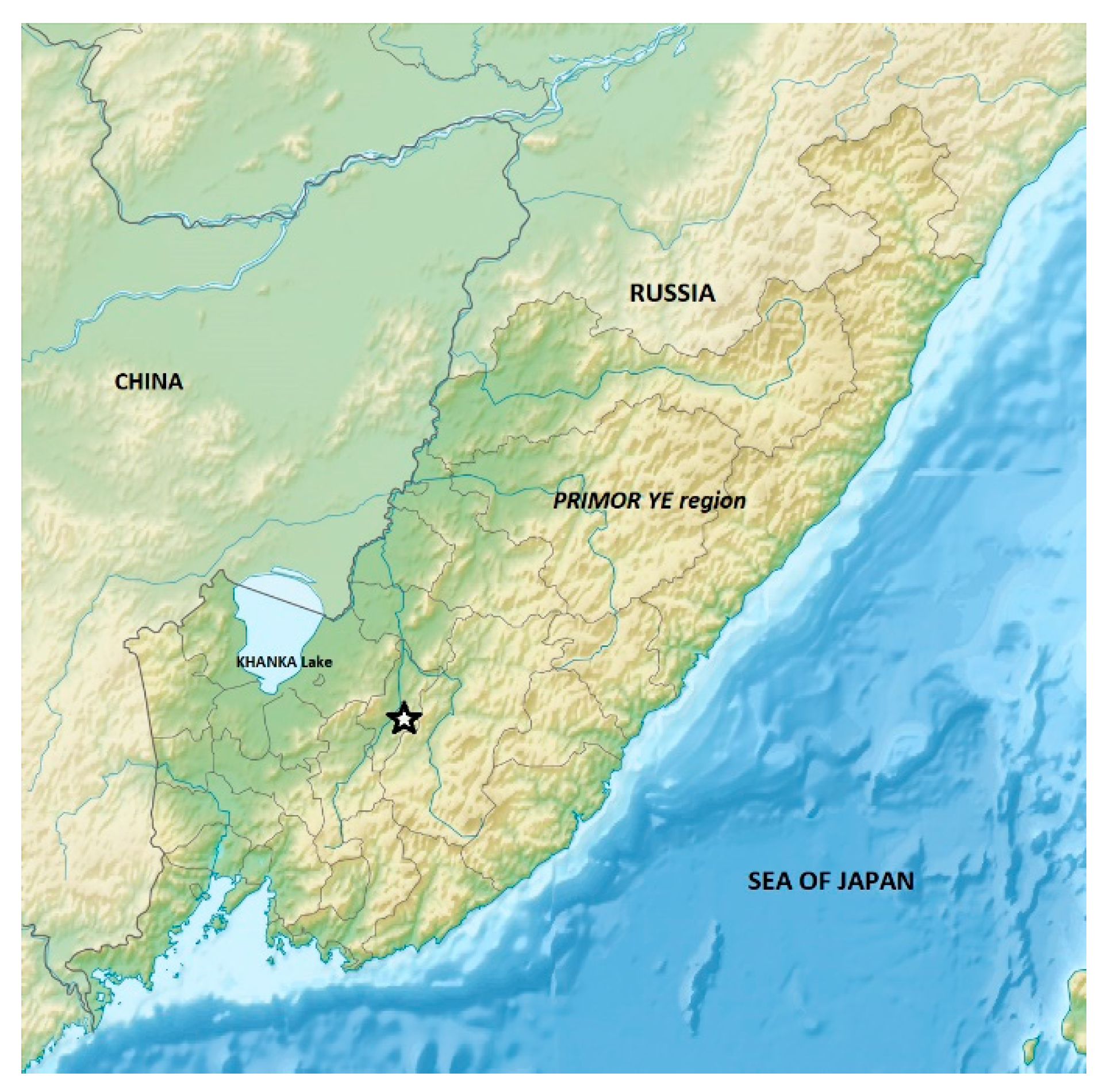
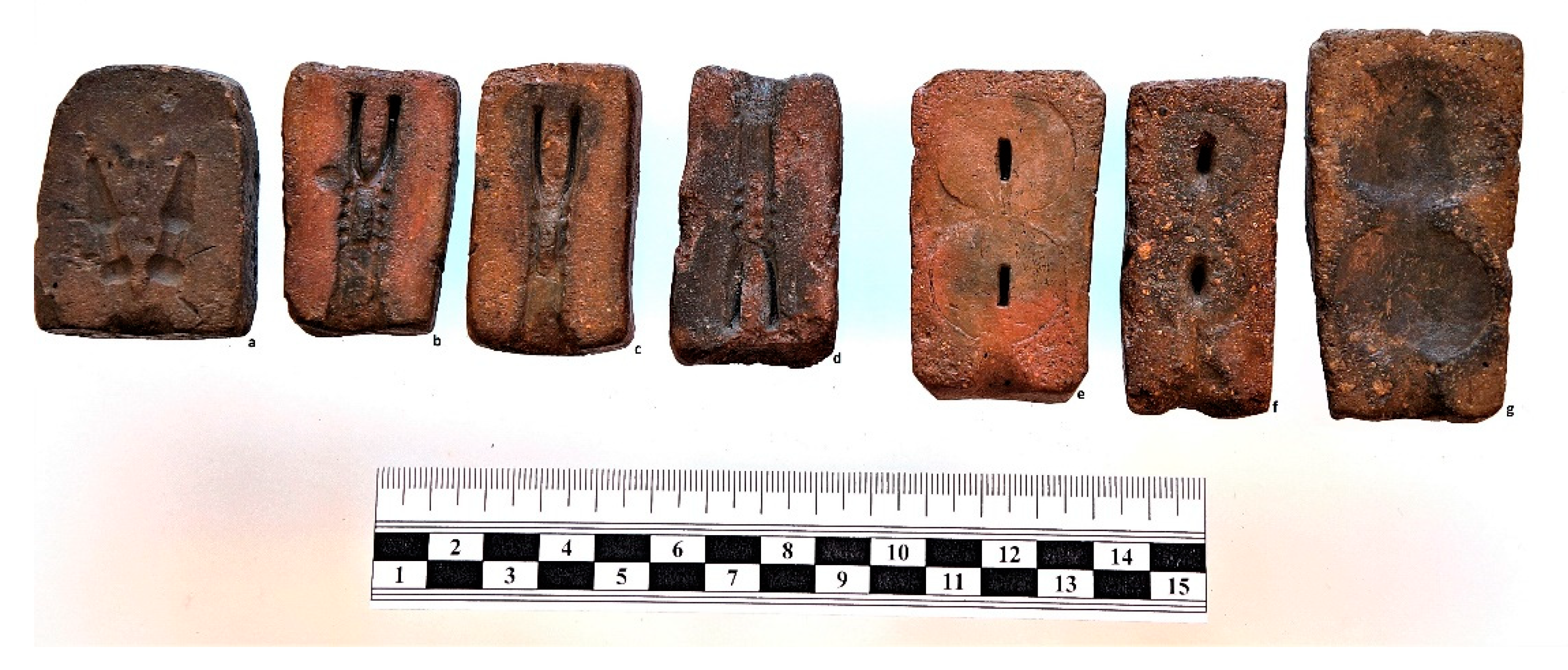
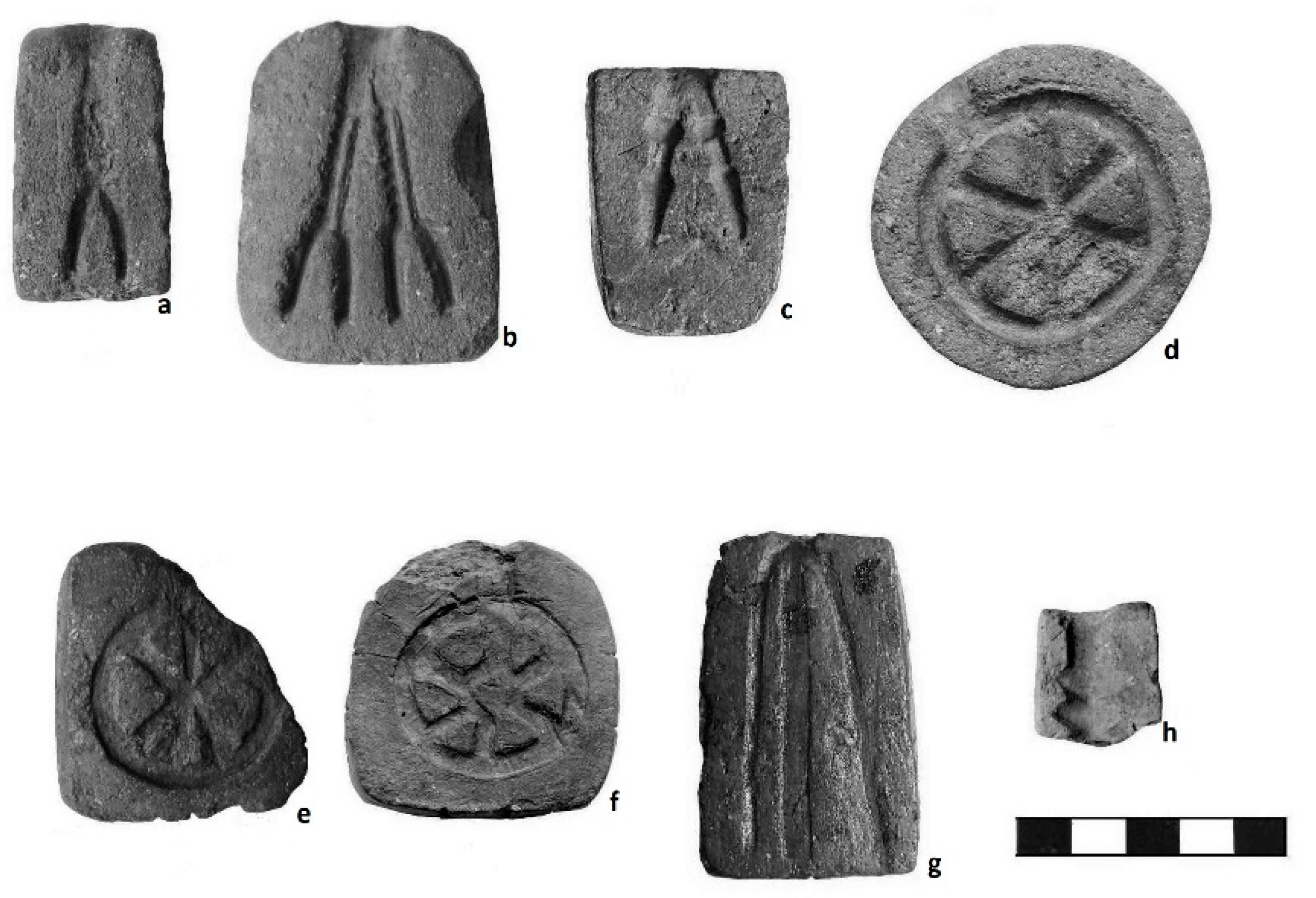
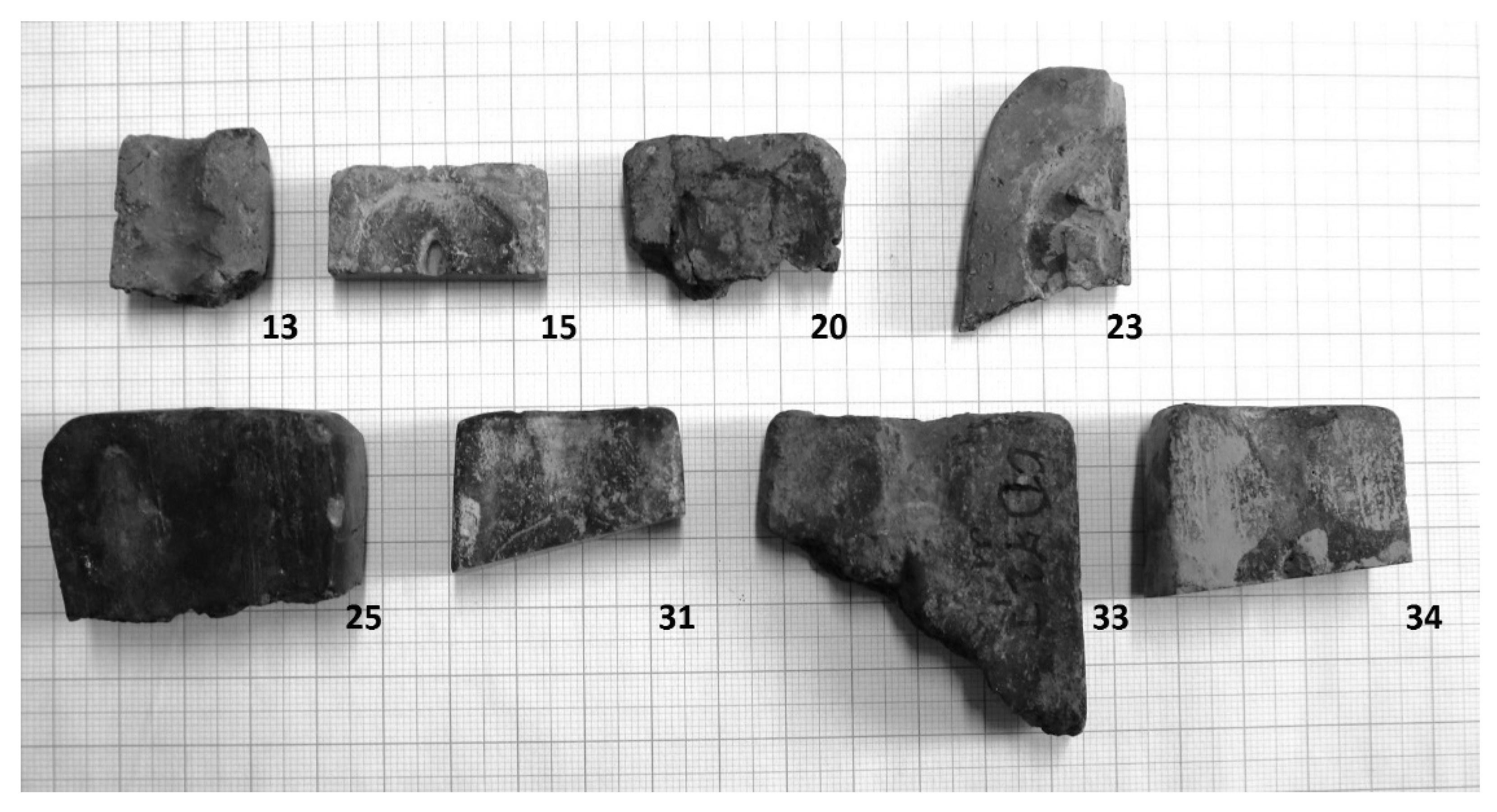
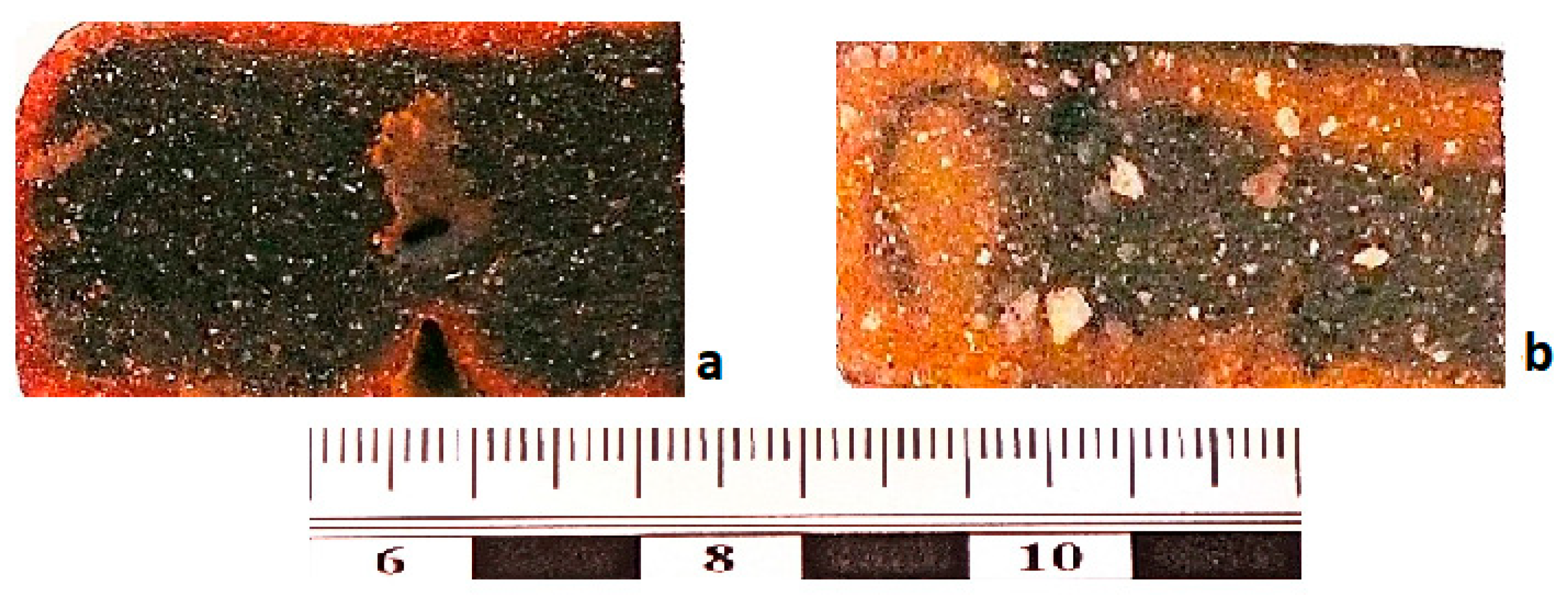

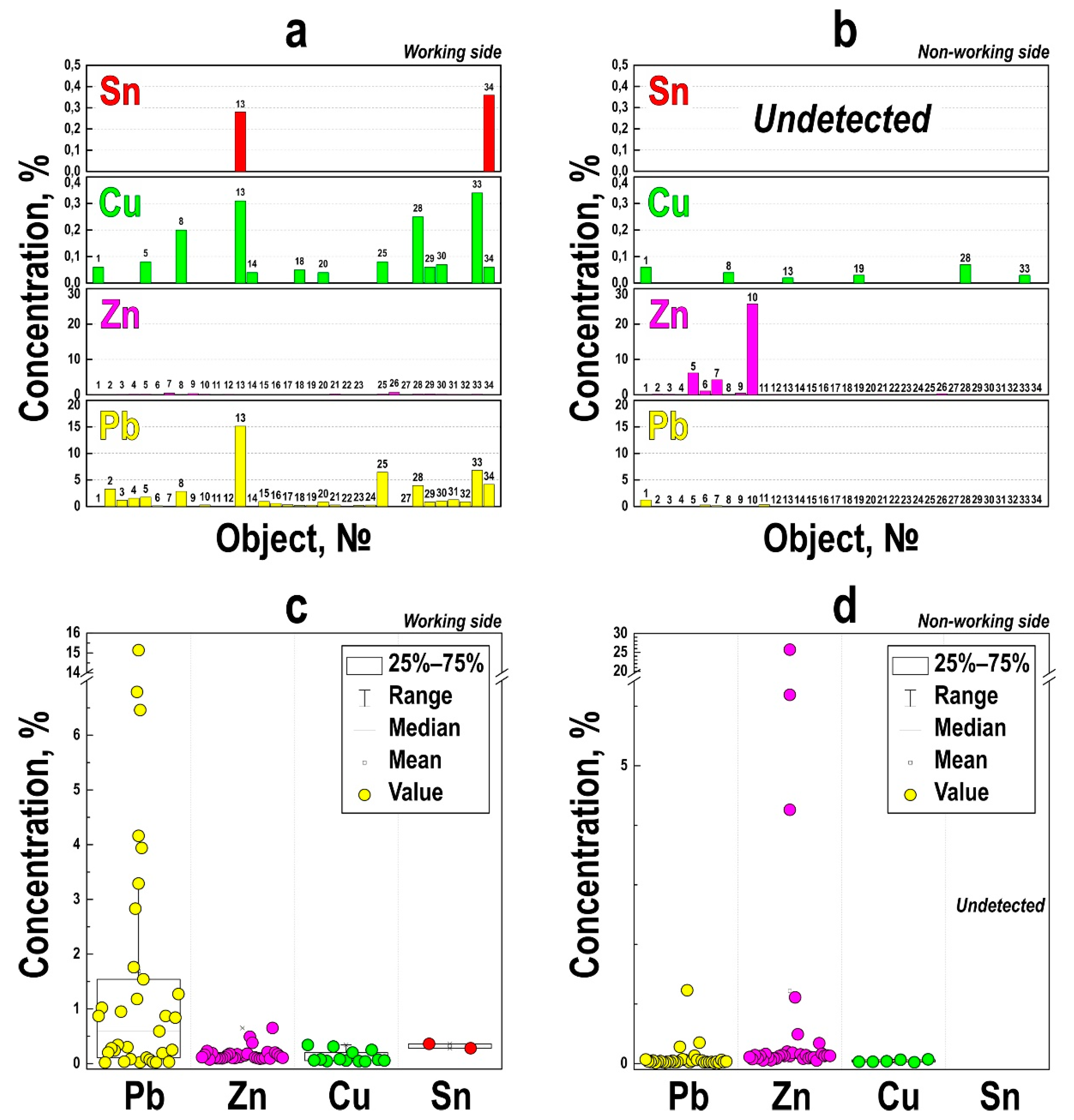
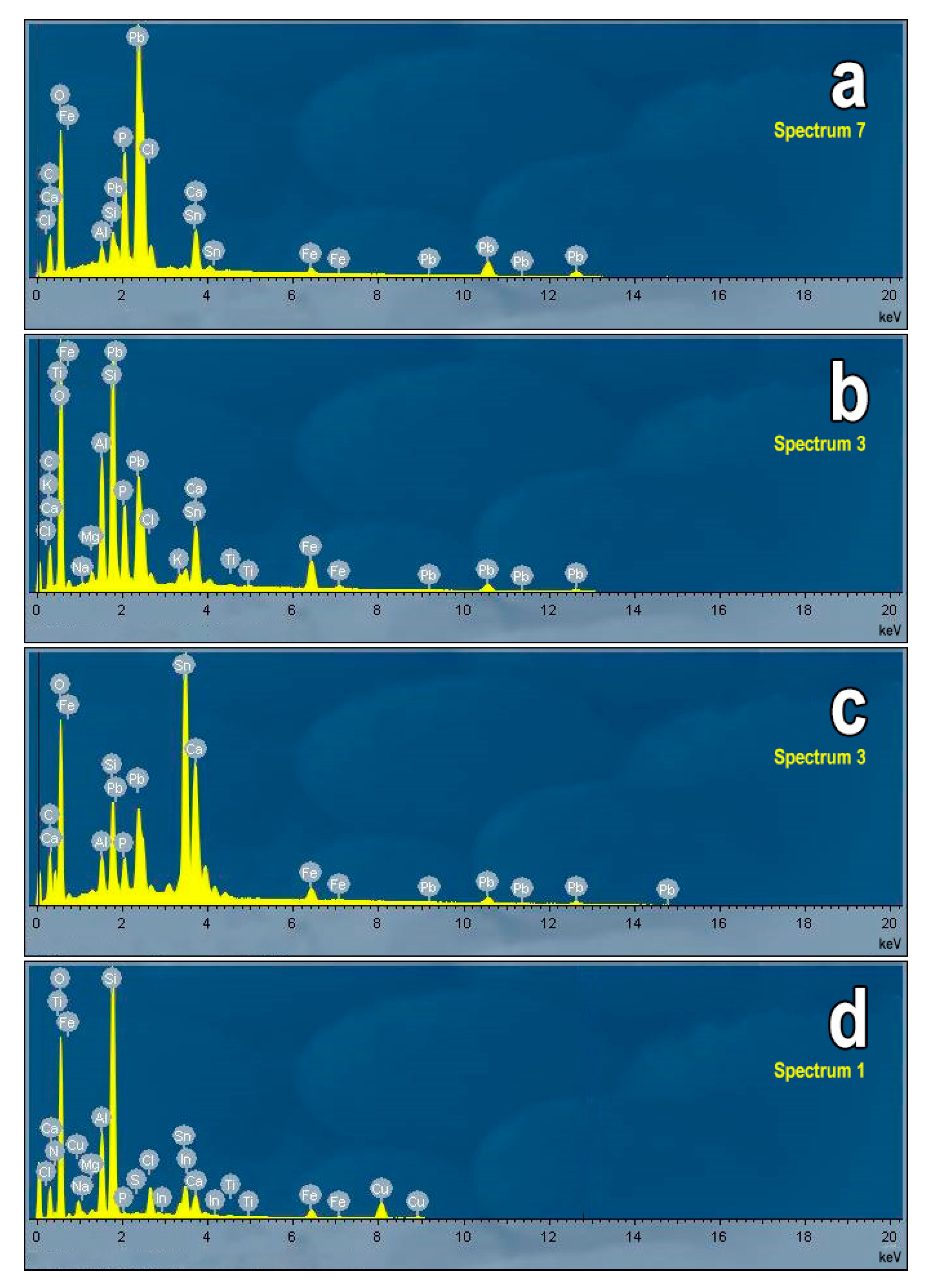
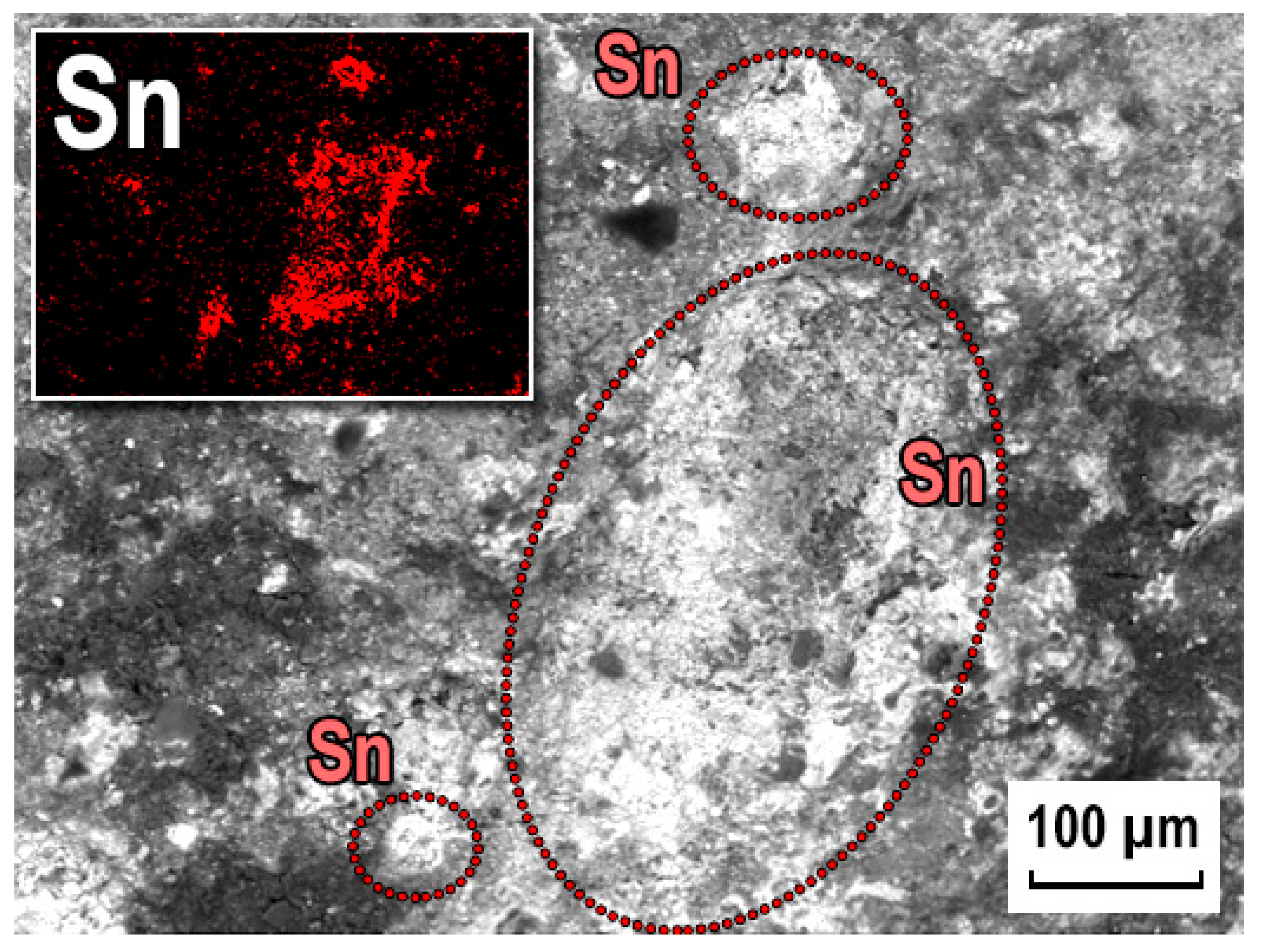
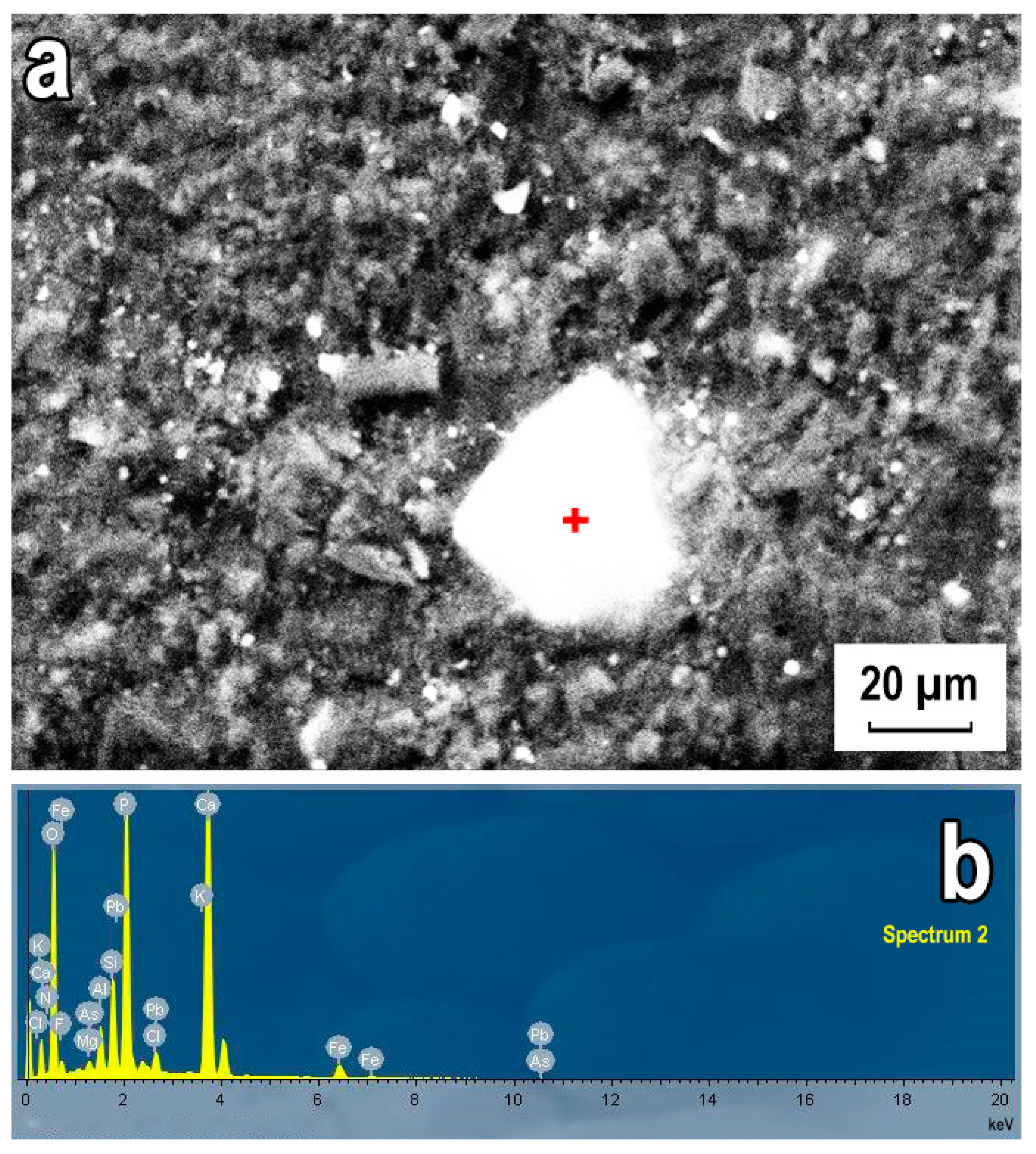
| Object Number | Kind of Object | Bronze Casting Type | Glue Covering | Carbonization of Working Surface | SEM-EDS Examined | pXRF Examined |
|---|---|---|---|---|---|---|
| 1 | Mold’s lid section (unbroken) | Not identified | + | + | − | + |
| 2 | Casting section of two-sided mold | Semi-spherical looped button | + | + | − | + |
| 3 | Casting section of one-sided mold | “two-tailed” object (pendant?) | + | + | − | + |
| 4 | Casting section of two-sided mold | Semi-spherical looped button | + | + | − | + |
| 5 | Casting section of two-sided mold | Semi-spherical looped button | + | + | − | + |
| 6 | Casting section of two-sided mold | Semi-spherical looped button | + | + | − | + |
| 7 | Casting section of one-sided mold | “Two-tailed” pair objects (pendants?) | + | + | − | + |
| 8 | Casting section of one-sided mold(fragment) | “Two-tailed” pair objects (pendants?) | + | + | − | + |
| 9 | Casting section of one-sided mold | “Three-tailed” object (pendant?) | + | + | − | + |
| 10 | Casting section of one-sided mold | Rosette-shaped object (ornament?) | + | + | − | + |
| 11 | Casting section of the mold(fragment) | Not identified | − | + | − | + |
| 12 | Casting section of the mold(fragment) | Not identified | − | + | − | + |
| 13 | Casting section of the mold (fragment) | Ornament? | − | + | + | + |
| 14 | Casting section of the mold (fragment) | Not identified | − | − | − | + |
| 15 | Casting section of two-sided mold (fragment) | Semi-spherical looped button | − | + | + | + |
| 16 | Casting section of two-sided mold (fragment) | Semi-spherical looped button | − | − | + | + |
| 17 | Casting section of the mold (fragment) | Not identified | − | - | + | + |
| 18 | Casting section of two-sided mold (fragment) | Semi-spherical looped button | − | + | + | + |
| 19 | Casting section of one-sided mold (fragment) | “Two-tailed” object (pendant?) | − | + | − | + |
| 20 | Casting section of two-sided mold (fragment) | Semi-spherical looped button | − | + | + | + |
| 21 | Casting section of one-sided mold (fragment) | “Two-tailed” object (pendant?) | − | + | + | + |
| 22 | Casting section of two-sided mold (fragment) | Semi-spherical looped button | − | − | + | + |
| 23 | Casting section of one-sided mold (fragment) | Semi-spherical looped button? | − | + | + | + |
| 24 | Casting section of two-sided mold (fragment) | Semi-spherical looped button | − | + | − | + |
| 25 | Mold’s lid section (fragment) | Not identified | − | + | + | + |
| 26 | Mold’s lid section | Not identified | − | − | + | + |
| 27 | Casting section of two-sided mold (fragment) | Semi-spherical looped button | − | − | − | + |
| 28 | Casting section of one-sided mold (fragment) | “Two-tailed” pair objects (pendants?) | + | + | − | + |
| 29 | Casting section of one-sided mold (fragment) | “Two-tailed” object (pendant?) | − | + | − | + |
| 30 | Casting section of two-sided mold | Semi-spherical looped button | + | + | − | + |
| 31 | Casting section of two-sided mold (fragment) | Semi-spherical looped button ? | − | + | + | + |
| 32 | Casting section of one-sided mold | “Two-tailed” object (pendant?) | + | + | − | + |
| 33 | Casting section of two-sided mold (fragment) | Semi-spherical looped button | − | + | + | + |
| 34 | Casting section of two-sided mold (fragment) | Semi-spherical looped button | − | + | + | + |
| Object Number | Si | Fe | Al | P | Ti | S | Pb | Mn | Zr | Zn | Cu | Ni | V | Bi | Nb | Cr | Sn |
|---|---|---|---|---|---|---|---|---|---|---|---|---|---|---|---|---|---|
| Working Side | |||||||||||||||||
| 1 | 43.87 | 28.87 | 20.84 | 1.78 | 1.73 | 1.65 | 0.02 | 0.79 | 0.14 | 0.14 | 0.06 | - | 0.11 | - | - | - | - |
| ±0.18 | ±0.16 | ±0.22 | ±0.03 | ±0.11 | ±0.03 | ±0.005 | ±0.04 | ±0.004 | ±0.01 | ±0.009 | ±0.03 | ||||||
| 2 | 47.49 | 25.66 | 17.81 | 2.24 | 2.55 | - | 3.29 | 0.55 | 0.24 | 0.12 | - | 0.05 | - | - | - | - | - |
| ±0.18 | ±0.16 | ±0.21 | ±0.03 | ±0.13 | ±0.04 | ±0.04 | ±0.006 | ±0.01 | ±0.01 | ||||||||
| 3 | 46.94 | 25.66 | 18.67 | 2.29 | 2.69 | 1.85 | 1.18 | 0.06 | 0.28 | 0.15 | - | 0.06 | 0.17 | - | - | - | - |
| ±0.19 | ±0.17 | ±0.22 | ±0.04 | ±0.14 | ±0.03 | ±0.02 | ±0.04 | ±0.006 | ±0.01 | ±0.02 | ±0.04 | ||||||
| 4 | 47.15 | 28.81 | 17.04 | 1.78 | 2.66 | - | 1.54 | 0.35 | 0.34 | 0.17 | - | - | 0.16 | - | - | - | - |
| ±0.2 | ±0.18 | ±0.24 | ±0.04 | ±0.14 | ±0.03 | ±0.03 | ±0.007 | ±0.01 | ±0.04 | ||||||||
| 5 | 51.16 | 26.11 | 15.98 | 1.09 | 2.69 | - | 1.76 | 0.39 | 0.33 | 0.18 | 0.08 | 0.07 | 0.16 | - | - | - | - |
| ±0.2 | ±0.17 | ±0.21 | ±0.03 | ±0.15 | ±0.03 | ±0.04 | ±0.007 | ±0.01 | ±0.01 | ±0.02 | ±0.04 | ||||||
| 6 | 44.84 | 27.75 | 19.63 | 2.00 | 2.50 | 1.57 | 0.11 | 0.99 | 0.27 | 0.10 | - | 0.08 | 0.16 | - | - | - | - |
| ±0.19 | ±0.18 | ±0.23 | ±0.03 | ±0.14 | ±0.03 | ±0.009 | ±0.05 | ±0.006 | ±0.01 | ±0.02 | ±0.04 | ||||||
| 7 | 34.30 | 42.20 | 15.33 | 1.33 | 3.54 | 1.59 | 0.08 | 0.55 | 0.59 | 0.49 | - | - | - | - | - | 0.17 | - |
| ±0.2 | ±0.25 | ±0.3 | ±0.04 | ±0.17 | ±0.04 | ±0.01 | ±0.05 | ±0.01 | ±0.03 | ±0.04 | |||||||
| 8 | 48.63 | 23.70 | 20.82 | 0.89 | 2.27 | - | 2.83 | 0.29 | 0.22 | 0.11 | 0.20 | 0.04 | - | - | - | - | - |
| ±0.17 | ±0.15 | ±0.2 | ±0.02 | ±0.12 | ±0.03 | ±0.03 | ±0.005 | ±0.008 | ±0.01 | ±0.01 | |||||||
| 9 | 32.76 | 45.35 | 12.42 | 2.05 | 3.42 | 2.09 | 0.07 | 0.61 | 0.61 | 0.38 | - | - | 0.24 | - | - | - | - |
| ±0.21 | ±0.27 | ±0.34 | ±0.04 | ±0.17 | ±0.05 | ±0.01 | ±0.05 | ±0.01 | ±0.03 | ±0.05 | |||||||
| 10 | 45.04 | 29.75 | 18.80 | 1.38 | 2.54 | 0.96 | 0.30 | 0.56 | 0.24 | 0.18 | - | 0.09 | 0.16 | - | - | - | - |
| ±0.18 | ±0.17 | ±0.23 | ±0.03 | ±0.12 | ±0.03 | ±0.01 | ±0.04 | ±0.005 | ±0.01 | ±0.02 | ±0.04 | ||||||
| 11 | 44.83 | 23.03 | 22.95 | 4.87 | 2.21 | 1.12 | 0.03 | 0.47 | 0.16 | 0.11 | - | 0.06 | 0.16 | - | 0.01 | - | - |
| ±0.15 | ±0.13 | ±0.18 | ±0.04 | ±0.1 | ±0.02 | ±0.004 | ±0.03 | ±0.003 | ±0.007 | ±0.009 | ±0.03 | ±0.002 | |||||
| 12 | 46.45 | 28.04 | 20.10 | 1.10 | 2.52 | 0.68 | 0.04 | 0.47 | 0.25 | 0.15 | - | 0.08 | 0.13 | - | - | - | - |
| ±0.2 | ±0.19 | ±0.22 | ±0.03 | ±0.15 | ±0.03 | ±0.007 | ±0.04 | ±0.006 | ±0.01 | ±0.02 | ±0.04 | ||||||
| 13 | 40.95 | 16.15 | 19.47 | 5.54 | 1.62 | - | 15.14 | 0.33 | 0.24 | 0.10 | 0.31 | - | 0.15 | - | - | - | 0.28 |
| ±0.14 | ±0.12 | ±0.17 | ±0.04 | 0.11 | ±0.08 | ±0.03 | ±0.006 | ±0.008 | ±0.01 | ±0.04 | ±0.03 | ||||||
| 14 | 49.38 | 23.98 | 20.59 | 2.34 | ±2.45 | 0.28 | 0.023 | 0.47 | 0.17 | 0.11 | 0.04 | - | 0.16 | - | - | - | - |
| ±0.18 | ±0.15 | ±0.2 | ±0.03 | ±0.12 | ±0.02 | ±0.004 | ±0.03 | ±0.004 | ±0.009 | ±0.008 | ±0.04 | ||||||
| 15 | 51.84 | 19.17 | 22.19 | 3.08 | 2.08 | - | 0.95 | 0.24 | 0.17 | 0.09 | - | - | 0.19 | - | - | - | - |
| ±0.16 | ±0.12 | ±0.18 | ±0.03 | ±0.1 | ±0.02 | ±0.02 | ±0.003 | ±0.006 | ±0.03 | ||||||||
| 16 | 53.02 | 17.64 | 23.79 | 1.14 | 1.90 | 1.33 | 0.59 | 0.20 | 0.18 | 0.10 | - | - | 0.11 | - | 0.02 | - | - |
| ±0.16 | ±0.11 | ±0.17 | ±0.02 | ±0.1 | ±0.02 | ±0.01 | ±0.02 | ±0.003 | ±0.006 | ±0.03 | ±0.002 | ||||||
| 17 | 48.58 | 22.31 | 21.06 | 3.72 | 2.32 | 0.44 | 0.34 | 0.64 | 0.25 | 0.10 | - | 0.05 | 0.20 | - | - | - | - |
| ±0.16 | ±0.13 | ±0.19 | ±0.04 | ±0.11 | ±0.02 | ±0.01 | ±0.03 | ±0.004 | ±0.007 | ±0.01 | ±0.03 | ||||||
| 18 | 52.33 | 19.94 | 21.84 | 1.67 | 2.10 | 1.08 | 0.19 | 0.27 | 0.18 | 0.10 | 0.05 | 0.05 | 0.21 | - | 0.02 | - | - |
| ±0.16 | ±0.12 | ±0.18 | ±0.03 | ±0.11 | ±0.02 | ±0.008 | ±0.02 | ±0.003 | ±0.007 | ±0.007 | ±0.01 | ±0.03 | ±0.002 | ||||
| 19 | 49.09 | 22.38 | 22.34 | 1.25 | 2.25 | 1.30 | 0.24 | 0.80 | 0.17 | 0.11 | - | 0.07 | - | - | - | - | |
| ±0.17 | ±0.15 | ±0.19 | ±0.03 | ±0.13 | ±0.03 | ±0.01 | ±0.04 | ±0.004 | ±0.009 | ±0.01 | |||||||
| 20 | 47.03 | 19.60 | 19.89 | 9.15 | 2.60 | - | 0.87 | 0.27 | 0.17 | 0.10 | 0.04 | 0.04 | 0.25 | - | 0.01 | - | - |
| ±0.15 | ±0.12 | ±0.18 | ±0.06 | ±0.11 | ±0.02 | ±0.02 | ±0.003 | ±0.007 | ±0.006 | ±0.009 | ±0.04 | ±0.002 | |||||
| 21 | 50.02 | 25.09 | 18.36 | 1.22 | 2.73 | 1.17 | 0.28 | 0.34 | 0.27 | 0.21 | - | 0.07 | 0.18 | 0.06 | - | - | - |
| ±0.19 | ±0.16 | ±0.2 | ±0.03 | ±0.14 | ±0.03 | ±0.01 | ±0.03 | ±0.006 | ±0.01 | ±0.02 | ±0.04 | ±0.007 | |||||
| 22 | 51.99 | 20.29 | 21.93 | 2.17 | 2.03 | 0.91 | 0.03 | 0.25 | 0.16 | 0.11 | - | - | 0.13 | - | - | - | - |
| ±0.17 | ±0.13 | ±0.18 | ±0.03 | ±0.11 | ±0.02 | ±0.004 | ±0.02 | ±0.003 | ±0.008 | ±0.03 | |||||||
| 23 | 49.83 | 23.06 | 21.45 | 1.54 | 2.48 | 0.55 | 0.20 | 0.45 | 0.22 | 0.09 | - | - | 0.13 | - | - | - | - |
| ±0.18 | ±0.15 | ±0.2 | ±0.03 | ±0.12 | ±0.02 | ±0.009 | ±0.03 | ±0.004 | ±0.008 | ±0.04 | |||||||
| 24 | 45.84 | 24.37 | 22.49 | 2.85 | 2.70 | 0.58 | 0.25 | 0.53 | 0.18 | - | - | - | 0.16 | 0.05 | - | - | - |
| ±0.17 | ±0.16 | ±0.2 | ±0.04 | ±0.13 | ±0.02 | ±0.01 | ±0.04 | ±0.003 | ±0.04 | ±0.006 | |||||||
| 25 | 35.21 | 23.10 | 16.91 | 14.92 | 2.27 | - | 6.46 | 0.33 | 0.30 | 0.19 | 0.08 | 0.04 | 0.19 | - | - | - | - |
| ±0.15 | ±0.15 | ±0.22 | ±0.08 | ±0.13 | ±0.05 | ±0.03 | ±0.006 | ±0.01 | ±0.01 | ±0.01 | ±0.04 | ||||||
| 26 | 42.32 | 35.32 | 13.87 | 2.68 | 3.24 | 0.55 | - | 0.84 | 0.28 | 0.65 | - | 0.10 | 0.15 | - | - | - | - |
| ±0.2 | ±0.2 | ±0.28 | ±0.04 | ±0.14 | ±0.03 | ±0.05 | ±0.006 | ±0.02 | ±0.02 | ±0.04 | |||||||
| 27 | 52.88 | 17.91 | 24.35 | 1.48 | 1.86 | 0.90 | 0.02 | 0.37 | 0.13 | 0.08 | - | - | - | 0.02 | - | - | - |
| ±0.15 | ±0.11 | ±0.17 | ±0.03 | ±0.1 | ±0.02 | ±0.003 | ±0.03 | ±0.003 | ±0.006 | ±0.003 | |||||||
| 28 | 43.11 | 28.00 | 19.71 | 0.76 | 2.39 | - | 3.94 | 1.08 | 0.28 | 0.20 | 0.25 | 0.05 | 0.12 | 0.11 | - | - | - |
| ±0.18 | ±0.17 | ±0.23 | ±0.03 | ±0.13 | ±0.05 | ±0.05 | ±0.006 | ±0.01 | ±0.02 | ±0.01 | ±0.04 | ±0.01 | |||||
| 29 | 48.09 | 26.23 | 19.30 | 1.13 | 2.23 | 1.22 | 0.84 | 0.18 | 0.26 | 0.23 | 0.06 | 0.07 | 0.16 | - | - | - | - |
| ±0.18 | ±0.16 | ±0.21 | ±0.03 | ±0.13 | ±0.03 | ±0.02 | ±0.03 | ±0.006 | ±0.01 | ±0.01 | ±0.01 | ±0.04 | |||||
| 30 | 46.66 | 24.29 | 19.97 | 1.58 | 2.46 | 2.93 | 1.02 | 0.31 | 0.24 | 0.17 | 0.07 | 0.08 | 0.22 | - | - | - | - |
| ±0.18 | ±0.16 | ±0.21 | ±0.03 | ±0.13 | ±0.04 | ±0.02 | ±0.03 | ±0.005 | ±0.01 | ±0.01 | ±0.02 | ±0.04 | |||||
| 31 | 53.07 | 11.99 | 20.22 | 10.54 | 2.17 | - | 1.27 | 0.35 | 0.23 | 0.16 | - | - | - | - | 0.02 | - | - |
| ±0.16 | ±0.11 | ±0.17 | ±0.06 | ±0.13 | ±0.02 | ±0.03 | ±0.004 | ±0.009 | ±0.002 | ||||||||
| 32 | 46.46 | 27.21 | 19.73 | 1.14 | 1.86 | 1.42 | 0.87 | 0.69 | 0.26 | 0.13 | - | 0.11 | 0.12 | - | - | 0.11 | - |
| ±0.2 | ±0.18 | ±0.23 | ±0.03 | ±0.13 | ±0.03 | ±0.02 | ±0.05 | ±0.006 | ±0.01 | ±0.02 | ±0.04 | ±0.03 | |||||
| 33 | 42.9 | 20.28 | 20.57 | 6.30 | 1.99 | - | 6.79 | 0.30 | 0.24 | 0.17 | 0.34 | 0.04 | 0.13 | - | 0.02 | - | - |
| ±0.14 | ±0.12 | ±0.18 | ±0.05 | ±0.1 | ±0.05 | ±0.02 | ±0.005 | ±0.008 | ±0.01 | ±0.009 | ±0.03 | ±0.003 | |||||
| 34 | 48.51 | 19.78 | 19.90 | 4.68 | 2.10 | - | 4.16 | 0.21 | 0.23 | 0.11 | 0.06 | 0.04 | 0.14 | 0.09 | - | - | 0.36 |
| ±0.16 | ±0.14 | ±0.18 | ±0.04 | ±0.12 | ±0.04 | ±0.03 | ±0.005 | ±0.008 | ±0.009 | ±0.01 | ±0.04 | ±0.01 | ±0.02 | ||||
| Non-Working Side | |||||||||||||||||
| 1 | 42.34 | 30.22 | 19.97 | 2.25 | 1.74 | 1.62 | 1.23 | 0.24 | 0.15 | 0.12 | 0.06 | 0.05 | - | - | - | - | - |
| ±0.17 | ±0.16 | ±0.22 | ±0.03 | ±0.1 | ±0.03 | ±0.02 | ±0.03 | ±0.004 | ±0.009 | ±0.05 | ±0.01 | ||||||
| 2 | 46.34 | 26.55 | 18.89 | 2.08 | 2.45 | 1.77 | 0.06 | 1.22 | 0.23 | 0.20 | - | 0.07 | 0.14 | - | - | - | - |
| ±0.18 | ±0.16 | ±0.23 | ±0.03 | ±0.12 | ±0.03 | ±0.006 | ±0.05 | ±0.005 | ±0.01 | ±0.01 | ±0.04 | ||||||
| 3 | 45.59 | 28.85 | 19.57 | 1.32 | 2.63 | 0.59 | 0.02 | 0.62 | 0.36 | 0.18 | - | 0.09 | 0.13 | 0.05 | - | - | - |
| ±0.19 | ±0.18 | ±0.24 | ±0.03 | ±0.13 | ±0.03 | ±0.006 | ±0.04 | ±0.006 | ±0.01 | ±0.02 | ±0.04 | ±0.007 | |||||
| 4 | 50.50 | 23.89 | 19.35 | 2.56 | 2.31 | 0.55 | 0.07 | 0.38 | 0.23 | 0.13 | - | - | - | 0.03 | 0.07 | - | - |
| ±0.17 | ±0.14 | ±0.2 | ±0.04 | ±0.11 | ±0.02 | ±0.006 | ±0.03 | ±0.004 | ±0.008 | ±0.005 | ±0.002 | ||||||
| 5 | 45.92 | 26.41 | 15.53 | 1.04 | 2.51 | 1.52 | 0.05 | 0.44 | 0.35 | 6.19 | - | 0.05 | - | - | - | - | - |
| ±0.2 | ±0.17 | ±0.25 | ±0.03 | ±0.14 | ±0.03 | ±0.007 | ±0.04 | ±0.007 | ±0.07 | ±0.02 | |||||||
| 6 | 5.55 | 83.88 | - | 0.30 | 2.93 | 1.79 | 0.28 | 1.49 | 2.26 | 1.11 | - | 0.41 | - | - | - | - | - |
| ±0.12 | ±0.29 | ±0.04 | ±0.21 | ±0.06 | ±0.05 | ±0.11 | ±0.05 | ±0.09 | ±0.12 | ||||||||
| 7 | 27.90 | 44.72 | 17.16 | 0.93 | 1.94 | 1.23 | 0.13 | 0.48 | 0.90 | 4.26 | - | - | 0.35 | - | 0.08 | - | - |
| ±0.22 | ±0.31 | ±0.39 | ±0.04 | ±0.17 | ±0.05 | ±0.02 | ±0.06 | ±0.02 | ±0.09 | ±0.06 | ±0.01 | ||||||
| 8 | 51.62 | 22.05 | 20.94 | 1.44 | 2.24 | 0.93 | 0.03 | 0.25 | 0.17 | 0.14 | 0.04 | 0.04 | 0.12 | - | - | - | - |
| ±0.17 | ±0.14 | ±0.19 | ±0.03 | ±0.11 | ±0.02 | ±0.004 | ±0.03 | ±0.004 | ±0.009 | ±0.008 | ±0.01 | ±0.03 | |||||
| 9 | 32.50 | 48.55 | 11.08 | 0.88 | 3.24 | 1.56 | 0.06 | 0.47 | 0.86 | 0.49 | - | - | 0.20 | 0.11 | - | 0.16 | - |
| ±0.22 | ±0.3 | ±0.37 | ±0.04 | ±0.17 | ±0.04 | ±0.01 | ±0.05 | ±0.02 | ±0.03 | ±0.05 | ±0.02 | ±0.04 | |||||
| 10 | 36.17 | 13.88 | 20.29 | 0.98 | 1.50 | 0.92 | 0.02 | 0.15 | 0.24 | 25.72 | - | 0.02 | 0.11 | - | - | - | - |
| ±0.15 | ±0.1 | ±0.24 | ±0.02 | ±0.08 | ±0.02 | ±0.005 | ±0.02 | ±0.005 | ±0.12 | ±0.007 | ±0.02 | ||||||
| 11 | 51.96 | 20.09 | 21.59 | 1.40 | 2.37 | 1.51 | 0.35 | 0.28 | 0.18 | 0.12 | - | - | 0.15 | - | - | - | - |
| ±0.17 | ±0.13 | ±0.18 | ±0.03 | ±0.12 | ±0.03 | ±0.01 | ±0.03 | ±0.004 | ±0.008 | ±0.04 | |||||||
| 12 | 45.95 | 24.74 | 18.16 | 3.10 | 2.17 | 4.76 | 0.05 | 0.49 | 0.24 | 0.15 | - | - | 0.15 | 0.04 | - | - | - |
| ±0.17 | ±0.16 | ±0.21 | ±0.04 | ±0.12 | ±0.04 | ±0.006 | ±0.04 | ±0.005 | ±0.01 | ±0.04 | ±0.006 | ||||||
| 13 | 53.98 | 17.26 | 22.51 | 2.01 | 1.66 | 1.82 | 0.05 | 0.34 | 0.14 | 0.08 | 0.02 | 0.03 | 0.10 | - | - | - | - |
| ±0.15 | ±0.1 | ±0.17 | ±0.03 | ±0.08 | ±0.03 | ±0.004 | ±0.02 | ±0.003 | ±0.005 | ±0.005 | ±0.007 | ±0.03 | |||||
| 14 | 49.84 | 22.05 | 23.11 | 1.23 | 2.21 | 0.78 | 0.03 | 0.46 | 0.16 | 0.08 | - | 0.05 | - | - | - | - | - |
| ±0.16 | ±0.13 | ±0.19 | ±0.03 | ±0.1 | ±0.02 | ±0.004 | ±0.03 | ±0.003 | ±0.006 | ±0.01 | |||||||
| 15 | 55.29 | 16.91 | 22.36 | 2.14 | 2.23 | 0.41 | 0.02 | 0.24 | 0.16 | 0.09 | - | 0.03 | 0.13 | - | - | - | - |
| ±0.16 | ±0.11 | ±0.16 | ±0.03 | ±0.1 | ±0.02 | ±0.003 | ±0.02 | ±0.003 | ±0.006 | ±0.008 | ±0.03 | ||||||
| 16 | 43.63 | 30.69 | 19.67 | 1.70 | 2.65 | 0.74 | 0.03 | 0.34 | 0.29 | 0.14 | - | - | 0.12 | - | 0.03 | - | - |
| ±0.18 | ±0.18 | ±0.22 | ±0.03 | ±0.14 | ±0.03 | ±0.006 | ±0.03 | ±0.006 | ±0.01 | ±0.04 | ±0.003 | ||||||
| 17 | 49.63 | 18.44 | 22.54 | 5.90 | 1.88 | 0.65 | 0.03 | 0.57 | 0.17 | 0.06 | - | - | 0.11 | 0.03 | 0.01 | - | - |
| ±0.15 | ±0.12 | ±0.17 | ±0.05 | ±0.1 | ±0.02 | ±0.003 | ±0.03 | ±0.003 | ±0.005 | ±0.03 | ±0.004 | ±0.002 | |||||
| 18 | 49.51 | 19.84 | 25.12 | 1.51 | 2.10 | 1.24 | 0.01 | 0.30 | - | 0.09 | - | 0.04 | 0.21 | 0.03 | 0.01 | - | - |
| ±0.16 | ±0.12 | ±0.18 | ±0.03 | ±0.1 | ±0.03 | ±0.003 | ±0.02 | ±0.007 | ±0.009 | ±0.03 | ±0.004 | ±0.002 | |||||
| 19 | 56.56 | 15.47 | 22.98 | 1.49 | 2.08 | 0.75 | 0.02 | 0.22 | 0.14 | 0.11 | 0.03 | - | 0.13 | 0.02 | - | - | - |
| ±0.16 | ±0.11 | ±0.16 | ±0.03 | ±0.1 | ±0.02 | ±0.003 | ±0.02 | ±0.003 | ±0.006 | ±0.005 | ±0.03 | ±0.003 | |||||
| 20 | 47.09 | 20.37 | 20.52 | 4.82 | 2.04 | 4.26 | 0.02 | 0.36 | 0.16 | 0.11 | - | 0.04 | 0.19 | 0.03 | 0.01 | - | - |
| ±0.15 | ±0.12 | ±0.18 | ±0.04 | ±0.1 | ±0.04 | ±0.003 | ±0.02 | ±0.003 | ±0.007 | ±0.008 | ±0.03 | ±0.003 | ±0.002 | ||||
| 21 | 49.82 | 24.84 | 19.44 | 1.57 | 2.65 | 0.6 | 0.03 | 0.41 | 0.21 | 0.16 | - | 0.05 | 0.19 | 0.04 | - | - | - |
| ±0.19 | ±0.15 | ±0.21 | ±0.03 | ±0.13 | ±0.02 | ±0.005 | ±0.03 | ±0.004 | ±0.01 | ±0.01 | ±0.04 | ±0.005 | |||||
| 22 | 49.08 | 20.06 | 22.92 | 3.38 | 2.16 | 1.69 | 0.04 | 0.29 | 0.13 | 0.10 | - | 0.03 | 0.12 | - | - | - | - |
| ±0.16 | ±0.12 | ±0.18 | ±0.04 | ±0.1 | ±0.03 | ±0.004 | ±0.02 | ±0.003 | ±0.006 | ±0.008 | ±0.03 | ||||||
| 23 | 55.16 | 16.75 | 24.04 | 1.09 | 2.08 | 0.38 | 0.01 | 0.24 | 0.14 | 0.05 | - | 0.02 | - | 0.03 | 0.01 | - | - |
| ±0.15 | ±0.11 | ±0.16 | ±0.02 | ±0.1 | ±0.02 | ±0.003 | ±0.02 | ±0.003 | ±0.005 | ±0.007 | ±0.003 | ±0.002 | |||||
| 24 | 55.09 | 17.22 | 22.51 | 1.99 | 2.20 | 0.38 | 0.03 | 0.23 | 0.18 | 0.05 | - | 0.04 | 0.09 | - | 0.01 | 0.08 | - |
| ±0.16 | ±0.11 | ±0.16 | ±0.03 | ±0.1 | ±0.02 | ±0.003 | ±0.02 | ±0.003 | ±0.005 | ±0.008 | ±0.03 | ±0.002 | ±0.02 | ||||
| 25 | 48.25 | 19.75 | 21.52 | 3.64 | 2.26 | 3.70 | 0.03 | 0.41 | 0.18 | 0.13 | - | 0.03 | 0.11 | - | 0.01 | - | - |
| ±0.15 | ±0.12 | ±0.18 | ±0.04 | ±0.1 | ±0.04 | ±0.004 | ±0.03 | ±0.003 | ±0.007 | ±0.008 | ±0.03 | ±0.002 | |||||
| 26 | 46.77 | 26.33 | 18.17 | 2.88 | 2.82 | 1.83 | 0.01 | 0.61 | 0.18 | 0.34 | - | 0.06 | - | - | - | - | - |
| ±0.18 | ±0.15 | ±0.22 | ±0.04 | ±0.12 | ±0.03 | ±0.004 | ±0.03 | ±0.004 | ±0.01 | ±0.01 | |||||||
| 27 | 49.40 | 20.07 | 23.56 | 2.25 | 2.23 | 1.50 | 0.01 | 0.5 | 0.16 | 0.10 | - | 0.04 | 0.16 | 0.03 | - | - | - |
| ±0.17 | ±0.13 | ±0.19 | ±0.03 | ±0.11 | ±0.03 | ±0.003 | ±0.03 | ±0.003 | ±0.007 | ±0.01 | ±0.03 | ±0.004 | |||||
| 28 | 45.94 | 28.24 | 18.97 | 2.08 | 2.22 | 1.13 | 0.05 | 0.61 | 0.24 | 0.16 | 0.07 | 0.11 | 0.18 | - | - | - | - |
| ±0.18 | ±0.16 | ±0.22 | ±0.03 | ±0.12 | ±0.03 | ±0.006 | ±0.04 | ±0.005 | ±0.01 | ±0.01 | ±0.02 | ±0.04 | |||||
| 29 | 47.10 | 26.51 | 20.15 | 1.28 | 2.15 | 1.94 | 0.06 | 0.24 | 0.25 | 0.14 | - | 0.07 | 0.11 | - | - | - | - |
| ±0.18 | ±0.16 | ±0.22 | ±0.03 | ±0.12 | ±0.03 | ±0.006 | ±0.03 | ±0.005 | ±0.01 | ±0.02 | ±0.04 | ||||||
| 30 | 47.55 | 27.97 | 18.61 | 1.39 | 2.70 | 0.75 | 0.03 | 0.33 | 0.26 | 0.13 | - | 0.06 | 0.18 | 0.04 | 0.02 | - | - |
| ±0.19 | ±0.16 | ±0.23 | ±0.03 | ±0.13 | ±0.03 | ±0.005 | ±0.03 | ±0.005 | ±0.01 | ±0.01 | ±0.04 | ±0.006 | ±0.003 | ||||
| 31 | 61.39 | 9.94 | 20.95 | 2.40 | 2.29 | 2.28 | 0.03 | 0.33 | 0.17 | 0.07 | - | - | 0.15 | - | - | - | - |
| ±0.17 | ±0.1 | ±0.16 | ±0.04 | ±0.12 | ±0.03 | ±0.003 | ±0.03 | ±0.003 | ±0.006 | ±0.04 | |||||||
| 32 | 50.49 | 23.5 | 21.22 | 0.86 | 1.92 | 0.36 | 0.04 | 1.17 | 0.20 | 0.13 | - | 0.11 | - | - | - | - | - |
| ±0.18 | ±0.14 | ±0.2 | ±0.02 | ±0.11 | ±0.02 | ±0.005 | ±0.05 | ±0.004 | ±0.009 | ±0.01 | |||||||
| 33 | 48.93 | 20.65 | 21.66 | 2.96 | 2.05 | 2.90 | 0.04 | 0.31 | 0.19 | 0.11 | 0.03 | 0.04 | 0.14 | - | 0.01 | - | - |
| ±0.15 | ±0.12 | ±0.18 | ±0.03 | ±0.1 | ±0.03 | ±0.004 | ±0.02 | ±0.003 | ±0.007 | ±0.006 | ±0.009 | ±0.03 | ±0.002 | ||||
| 34 | 48.08 | 21.36 | 18.75 | 6.96 | 2.07 | 1.86 | 0.07 | 0.4 | 0.19 | 0.13 | - | - | 0.14 | - | 0.02 | - | - |
| ±0.17 | ±0.14 | ±0.2 | ±0.05 | ±0.12 | ±0.03 | ±0.006 | ±0.03 | ±0.004 | ±0.009 | ±0.04 | ±0.002 | ||||||
| Object Number | Chemical Elements, Weight % | |||||||||||||||||||||||
|---|---|---|---|---|---|---|---|---|---|---|---|---|---|---|---|---|---|---|---|---|---|---|---|---|
| C | O | Al | Si | Na | Mg | Ca | K | P | Cl | F | Fe | Ti | Mn | Pb | Sn | Cu | Zr | Ba | In | As | Ce | N | S | |
| 13 | 7.97–57.40 | 31.54–56.20 | 1.93–9.81 | 4.48–28.33 | 2.92–3.47 | - | 1.27–5.75 | 1.38–8.71 | 1.00–5.97 | 1.24 | - | 1.58–13.72 | 1.38 | 7.25 | 1.59–34.25 | 3.76–27.14 | 2.02 | - | - | - | 1.36 | - | - | - |
| 15 | 1.16–4.59 | 53.07–60.20 | 6.53–8.59 | 22.35–29.10 | 1.08–2.68 | - | 1.04–1.13 | 1.25–3.04 | - | 3.29–4.25 | - | 1.88–5.71 | 1.15–1.63 | - | - | 9.10 | 10.69 | - | - | 1.75 | - | - | - | - |
| 18 | 13.58–13.73 | 42.45–57.28 | 1.83–13.31 | 23.13–43.28 | - | - | 1.07–6.77 | 1.11–7.98 | 1.26 | 1.26–5.78 | - | 1.19–7.83 | - | - | - | - | - | - | - | - | - | - | - | - |
| 20 | 8.65–34.95 | 38.80–57.50 | 2.33–13.30 | 4.52–30.24 | 1.18–3.68 | 1.02–4.38 | 1.11–19.44 | 1.12–10.36 | 1.20–3.22 | - | - | 1.01–12.68 | 1.02 | - | 3.63–8.64 | - | ≤1.00 | - | 1.92 | - | - | - | - | - |
| 23 | 4.27–12.55 | 41.60–58.74 | 3.41–9.50 | 9.77–37.11 | - | - | 1.10–1.60 | 1.04–7.94 | - | 1.04–3.84 | - | 2.07–21.39 | 13.38 | 1.56 | - | - | 1.04–3.92 | - | - | - | - | - | - | - |
| 25 | 10.09–42.34 | 20.16–51.83 | 1.01–7.02 | 1.20–19.40 | - | - | 1.55–11.83 | 2.88–12.67 | 1.01–11.63 | 1.25–2.57 | - | 1.44–5.46 | 1.53 | - | 3.83–52.56 | 1.13–4.98 | - | - | 2.00 | - | - | - | 7.72–10.14 | - |
| 31 | 2.28–9.27 | 41.33–63.33 | 1.43–13.30 | 2.96–39.39 | 1.21–4.82 | 2.35–6.62 | 1.96–17.23 | 1.02–8.77 | 2.24–11.34 | 1.01–6.86 | 2.81–9.27 | 2.14–11.36 | - | - | 1.34–9.28 | 1.48 | - | - | - | - | - | - | - | - |
| 33 | 7.13–47.99 | 33.45–52.54 | 2.25–8.52 | 3.72–16.26 | - | - | 1.29–3.82 | 1.10–2.61 | 1.10–6.08 | 1.07–1.40 | - | 2.03–9.31 | - | - | 1.22–38.84 | - | - | - | - | - | - | - | - | - |
| 34 | 7.86–24.82 | 31.68–46.01 | 1.04–7.68 | 1.32–12.41 | - | - | 1.14–6.25 | 2.35 | 1.38–6.53 | 1.11–1.46 | - | 1.08–4.88 | - | - | 9.91–38.97 | 1.43–33.86 | - | - | - | - | - | - | - | - |
| 16 | 1.70–6.68 | 37.75–60.51 | 2.31–13.06 | 15.79–43.40 | 1.52–3.51 | 1.08–1.20 | 1.00–2.10 | 1.57–8.31 | - | 2.10–14.18 | - | 1.31–24.13 | 1.14–1.20 | - | - | - | - | - | - | - | - | - | - | - |
| 17 | 3.12–9.49 | 35.11–61.16 | 4.28–11.36 | 12.16–33.03 | 2.55–2.92 | 2.16 | 1.00–3.83 | 1.09–11.48 | 1.08–1.12 | 1.09–4.46 | - | 2.02–18.13 | 1.20–12.47 | 1.49 | - | - | - | 12.48 | - | - | - | 1.03 | - | - |
| 22 | 7.89–20.50 | 46.37–66.06 | 5.85–11.92 | 11.79–38.50 | 4.22 | 1.18–1.43 | 1.37–2.45 | 1.04–5.11 | 1.37 | 1.16–2.48 | - | 2.71–9.37 | 1.37 | - | - | - | - | - | - | - | - | - | - | 1.11 |
| 26 | 4.69–10.34 | 44.90–54.68 | 4.53–9.25 | 19.21–26.00 | 1.38–1.84 | 1.04–1.11 | 1.51–7.00 | 1.13–5.01 | - | 2.12 | - | 3.35–7.89 | - | - | - | - | - | - | - | - | - | - | - | - |
| Spectrum, Number | Chemical Elements, Weight % | ||||||||||||||||||||
|---|---|---|---|---|---|---|---|---|---|---|---|---|---|---|---|---|---|---|---|---|---|
| C | O | Al | Si | Na | Mg | Ca | K | P | Cl | Fe | Ti | Mn | Pb | Sn | Cu | Ba | In | As | S | N | |
| N13/1/2 | 9.07 | 44.12 | 4.94 | 11.49 | 0.42 | 0.19 | 1.05 | 1.62 | 0.18 | 0.25 | 2.24 | 0.22 | - | 15.05 | 1.91 | 0.32 | - | - | 1.36 | - | 5.60 |
| N13/1/3 | 16.86 | 34.34 | 4.23 | 9.94 | 0.31 | 0.42 | 2.13 | 1.62 | 0.34 | 0.36 | 10.64 | 0.63 | - | 12.02 | 3.61 | 2.02 | - | - | 0.52 | - | - |
| N13/1/7 | 17.72 | 46.26 | 4.00 | 10.37 | 0.31 | 0.32 | 1.42 | 1.20 | 0.35 | 0.20 | 3.20 | 0.30 | - | 6.43 | 1.87 | - | - | - | 0.59 | - | 5.46 |
| N13/4/13 | 13.91 | 36.59 | 3.69 | 8.33 | 0.18 | 0.37 | 3.09 | 1.22 | 4.48 | 0.55 | 4.77 | 0.25 | - | 22.57 | - | - | - | - | - | - | - |
| N13/4/19 | 52.90 | 9.00 | 26.29 | 3.14 | 0.38 | 3.61 | 1.33 | 0.51 | 1.24 | 3.23 | 0.19 | - | 34.25 | - | - | - | - | - | - | - | |
| N15/1/1 | - | 60.20 | 6.90 | 22.35 | 0.51 | 0.44 | 1.04 | - | 0.33 | 3.29 | 2.93 | 0.25 | - | - | 9.10 | 10.69 | - | 1.75 | - | 0.23 | - |
| N15/1/2 | 1.81 | 53.59 | 7.41 | 25.49 | 0.49 | 0.41 | 1.13 | 1.94 | 0.57 | 4.25 | 2.92 | 0.34 | - | - | - | 0.93 | - | - | - | 0.54 | - |
| N15/2/6 | - | 48.60 | 9.51 | 24.74 | 0.45 | 0.69 | 2.36 | 3.90 | 1.12 | 0.56 | 5.03 | 0.92 | - | - | - | 0.60 | - | - | - | - | - |
| N20/1/3 | 9.73 | 50.71 | 8.29 | 17.92 | 0.64 | 0.98 | 1.44 | 0.90 | 0.41 | - | 7.90 | 0.86 | 0.12 | - | - | 0.20 | - | - | - | - | - |
| N20/1/8 | 10.06 | 53.70 | 7.57 | 16.03 | 0.79 | 1.01 | 1.24 | 0.98 | 0.69 | - | 7.29 | 0.25 | 0.12 | - | - | 0.27 | - | - | - | - | - |
| N20/3/10 | 21.14 | 38.80 | 5.72 | 17.16 | 0.28 | 0.21 | 1.43 | 7.17 | 1.91 | 0.17 | 1.47 | - | - | 3.63 | - | - | 0.92 | - | - | - | - |
| N20/3/9 | 19.37 | 39.64 | 4.66 | 13.20 | 0.27 | 0.31 | 2.80 | 4.58 | 3.22 | 0.39 | 2.55 | 0.37 | - | 8.64 | - | - | - | - | - | - | - |
| N23/1/2 | 7.99 | 45.79 | 7.40 | 24.20 | 0.44 | 0.20 | 0.61 | 7.94 | 0.22 | 1.04 | 3.38 | 0.28 | - | - | - | 0.51 | - | - | - | - | - |
| N23/1/5 | - | 56.27 | 6.68 | 25.40 | 0.43 | 0.47 | 0.67 | 2.55 | 0.20 | 1.83 | 2.88 | 0.28 | - | - | - | 2.33 | - | - | - | - | - |
| N23/1/6 | - | 48.51 | 7.77 | 26.58 | 0.39 | 0.48 | 1.45 | 3.30 | 0.26 | 2.04 | 8.06 | 0.62 | - | - | - | 0.55 | - | - | - | - | - |
| N25/1/1 | - | 42.32 | 6.51 | 19.19 | 0.53 | 0.17 | 2.73 | 12.67 | 2.35 | 0.78 | 1.32 | - | - | 9.44 | - | - | 2.00 | - | - | - | - |
| N25/1/4 | - | 36.35 | 1.49 | 1.85 | - | 0.23 | 7.85 | - | 7.87 | 1.79 | 1.69 | - | - | 37.09 | 3.78 | - | - | - | - | - | - |
| N25/1/9 | 19.11 | 36.43 | 1.71 | 3.19 | 0.23 | 0.28 | 5.88 | - | 5.39 | 1.14 | 1.96 | - | - | 23.18 | 2.93 | - | - | - | - | - | - |
| N25/2/1 | 15.92 | 35.44 | 2.18 | 4.63 | - | 0.41 | 6.32 | - | 5.21 | 1.16 | 2.28 | - | - | 22.13 | 4.38 | - | - | - | - | - | - |
| N25/2/19 | 20.19 | 39.42 | 2.51 | 6.54 | - | 0.33 | 6.75 | 0.61 | 5.51 | 0.96 | 3.12 | - | - | 19.95 | 3.48 | - | - | - | - | - | - |
| N31/ 1/1 | - | 51.66 | 3.37 | 7.14 | 0.25 | 0.45 | 4.36 | 0.43 | 4.37 | 3.39 | 4.90 | 0.20 | - | 9.28 | 1.48 | - | - | - | - | - | 8.73 |
| N31/1/3 | - | 56.41 | 3.94 | 6.62 | 0.39 | 0.98 | 3.51 | 0.23 | 4.08 | 3.51 | 3.70 | 0.17 | - | 6.57 | 0.91 | - | - | - | - | - | 8.11 |
| N31/1/14 | - | 55.19 | 5.52 | 10.29 | 0.30 | 6.62 | 3.11 | 0.50 | 2.78 | 2.50 | 3.48 | 0.19 | - | 5.81 | 1.04 | - | - | - | - | - | - |
| N33/1/3 | - | 39.41 | 2.76 | 4.39 | - | 0.24 | 3.57 | 0.41 | 6.08 | 1.40 | 2.30 | - | - | 38.84 | - | - | - | - | 0.60 | - | - |
| N33/1/8 | - | 37.79 | 3.30 | 5.69 | - | 0.30 | 3.82 | 0.54 | 5.94 | 1.25 | 3.08 | - | - | 38.28 | - | - | - | - | - | - | - |
| N33/1/11 | 9.31 | 48.31 | 5.56 | 11.30 | 0.25 | 0.53 | 2.03 | 1.10 | 2.75 | 0.40 | 4.36 | 0.33 | - | 13.77 | - | - | - | - | - | - | - |
| N34/1/3 | 7.86 | 39.49 | 1.31 | 3.21 | - | - | 1.14 | - | 1.38 | - | 1.83 | - | - | 9.91 | 33.86 | - | - | - | - | - | - |
| N34/2/5 | - | 46.01 | 2.81 | 5.52 | 0.37 | 0.30 | 4.04 | 0.59 | 6.07 | 1.46 | 2.15 | - | - | 37.97 | 3.91 | - | - | - | - | - | - |
| N34/2/6 | 13.57 | 31.68 | 1.09 | 1.75 | 0.17 | 0.20 | 4.68 | - | 6.53 | 0.69 | 3.61 | - | - | 34.14 | 2.50 | - | - | - | - | - | - |
| N34/3/2 | 20.11 | 36.34 | 2.41 | 4.64 | 0.26 | 0.25 | 3.43 | - | 2.95 | 0.30 | 2.69 | - | - | 12.39 | - | - | - | - | - | - | - |
| N34/3/6 | 8.72 | 37.68 | 1.06 | 1.83 | 0.15 | - | 1.91 | - | 3.06 | 0.43 | 1.50 | - | - | 16.65 | 27.14 | - | - | - | - | - | - |
Publisher’s Note: MDPI stays neutral with regard to jurisdictional claims in published maps and institutional affiliations. |
© 2021 by the authors. Licensee MDPI, Basel, Switzerland. This article is an open access article distributed under the terms and conditions of the Creative Commons Attribution (CC BY) license (https://creativecommons.org/licenses/by/4.0/).
Share and Cite
Zhushchikhovskaya, I.S.; Buravlev, I.Y. Ancient Ceramic Casting Molds from the Southern Russian Far East: Identification of Alloy Traces via Application of Nondestructive SEM-EDS and pXRF Methods. Heritage 2021, 4, 2643-2667. https://doi.org/10.3390/heritage4040149
Zhushchikhovskaya IS, Buravlev IY. Ancient Ceramic Casting Molds from the Southern Russian Far East: Identification of Alloy Traces via Application of Nondestructive SEM-EDS and pXRF Methods. Heritage. 2021; 4(4):2643-2667. https://doi.org/10.3390/heritage4040149
Chicago/Turabian StyleZhushchikhovskaya, Irina S., and Igor Yu. Buravlev. 2021. "Ancient Ceramic Casting Molds from the Southern Russian Far East: Identification of Alloy Traces via Application of Nondestructive SEM-EDS and pXRF Methods" Heritage 4, no. 4: 2643-2667. https://doi.org/10.3390/heritage4040149
APA StyleZhushchikhovskaya, I. S., & Buravlev, I. Y. (2021). Ancient Ceramic Casting Molds from the Southern Russian Far East: Identification of Alloy Traces via Application of Nondestructive SEM-EDS and pXRF Methods. Heritage, 4(4), 2643-2667. https://doi.org/10.3390/heritage4040149






